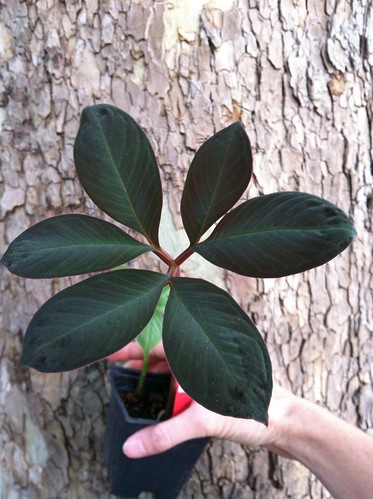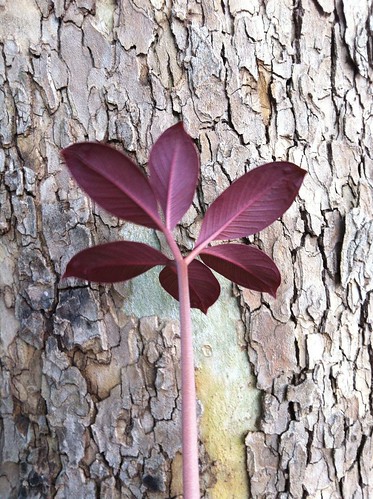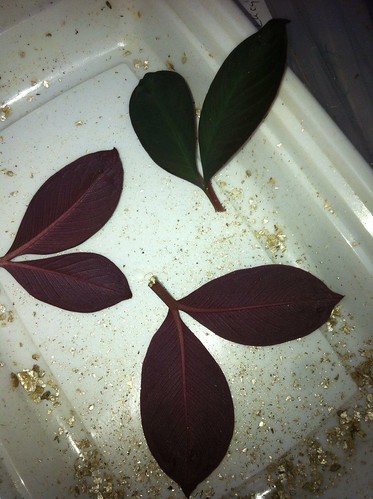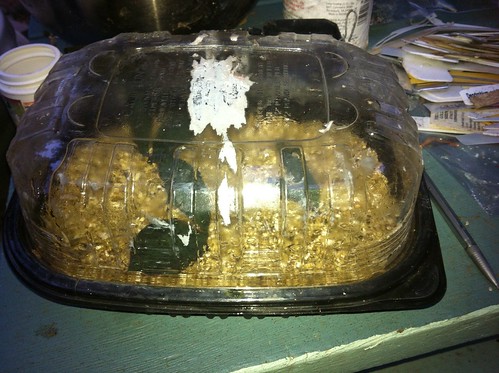Last week my Amorphophallus atroviridis arose from its winter-long slumber and burst from the ground with the prettiest leaves you've ever seen in your life. I was taking photos of both surfaces of the leaves when the unthinkable happened. One moment the plant was fine; the next moment the petiole was broken off at the surface. That second moment was not a good moment.
So what did I do?
I cried. (I bet you thought I was going to say I made lemonade.)
What did I do next?
I cried some more.
But after that?
Are you kidding? I was still crying.
Eventually I got my life back together and decided to do something with the beautiful leaf that used to be a plant. I stuck it in a vase of water and sent an email to my friends, asking if they had tried rooting Amorphophallus from leaf cuttings before. I was pretty sure I had heard this was possible, and I had already successfully done this with Zamioculcuas, another tuberous aroid. Yes, some of them had! Their suggestions were along the lines of how I normally treat plant cuttings. Prepare a container with a good rooting media, thoroughly moisten the media, use a little rooting hormone (or crushed Advil) on the cut end of your stem, make a divot in your media, insert the cutting, pack media around the stem so it is stationary, seal the environment to maintain high humidity.
The media can be perlite, vermiculite, soil or other things. I used vermiculite because that is what I had on hand and because it has worked well for me for other types of cuttings.
Many people will put their cuttings in pots and then put the pot in a Ziplock bag. I like to use take-out containers.
With time and patience, the tip of the cutting will eventually form roots and a new tuber. The leaf will probably die back and new growth will emerge. That's if all goes well. If all doesn't go well, the leaves will perish, leaving no tuber or roots behind. Today I read an article on success rates of rooting different species of Amorphophallus from leaf cuttings. The success rate is very low for this particular species. I hope that I am lucky and get at least one tuber out of this experiment. If so, I will have made lemonade.
 |
| Amorphophallus atroviridis - adaxial leaf surface |
 |
| Amorphophallus atroviridis - abaxial leaf surface |
So what did I do?
I cried. (I bet you thought I was going to say I made lemonade.)
What did I do next?
I cried some more.
But after that?
Are you kidding? I was still crying.
Eventually I got my life back together and decided to do something with the beautiful leaf that used to be a plant. I stuck it in a vase of water and sent an email to my friends, asking if they had tried rooting Amorphophallus from leaf cuttings before. I was pretty sure I had heard this was possible, and I had already successfully done this with Zamioculcuas, another tuberous aroid. Yes, some of them had! Their suggestions were along the lines of how I normally treat plant cuttings. Prepare a container with a good rooting media, thoroughly moisten the media, use a little rooting hormone (or crushed Advil) on the cut end of your stem, make a divot in your media, insert the cutting, pack media around the stem so it is stationary, seal the environment to maintain high humidity.
 |
| Amorphophallus atroviridis leaf cuttings |
The media can be perlite, vermiculite, soil or other things. I used vermiculite because that is what I had on hand and because it has worked well for me for other types of cuttings.
 |
| Cuttings inserted in the media |
Many people will put their cuttings in pots and then put the pot in a Ziplock bag. I like to use take-out containers.
 |
| Sealed in their rooting environment |
With time and patience, the tip of the cutting will eventually form roots and a new tuber. The leaf will probably die back and new growth will emerge. That's if all goes well. If all doesn't go well, the leaves will perish, leaving no tuber or roots behind. Today I read an article on success rates of rooting different species of Amorphophallus from leaf cuttings. The success rate is very low for this particular species. I hope that I am lucky and get at least one tuber out of this experiment. If so, I will have made lemonade.
No comments:
Post a Comment